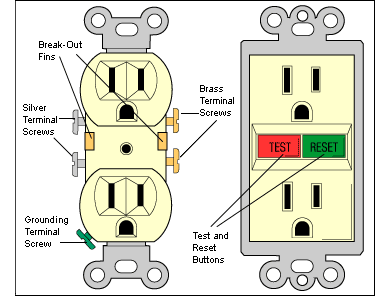 Outlets
OutletsOutlets, also known as receptacles, are the places where you plug in your lamps, computers, toaster ovens, and blow dryers. Some include a half-round hole for the
grounding plug on a cord. Older houses may not have outlets with
grounding holes, in which case you probably have two-prong adapters
to ground your appliances and lighting. If you have to replace an
outlet, install a grounding box unless the system isn't grounded
with a grounding wire or metal conduit.
How do you know if the system has a grounding wire? First turn
off the power. Check an outlet with a circuit tester to make sure
it's off, and remove it from the wall. It should have three
different-colored terminal screws: brass screws for black (hot)
wires, silver screws for white (neutral) wires, and a green screw
for the ground wire. The green terminal screw should be connected
either to a bare wire or to a metal electrical box. If it isn't,
consult an electrician to find out whether your system is properly
grounded.
Outlets for 240-volt appliances that draw a lot of current (such
as dryers, ranges, and air conditioners) have different
configurations. Never force a plug into a outlet that doesn't
accommodate it. Always replace old outlets with new ones that have
the same amperage and voltage. |
|
Outlets: Introduction I Common Problems I Easy Repairs | |